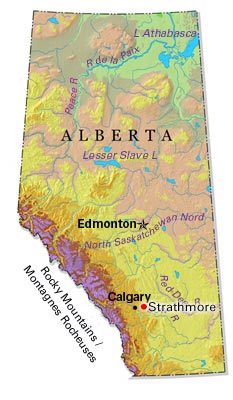Gibbons, Alta, incorporated as a town in 1977, population 3030 (2011c), 2642 (2006c). The Town of Gibbons is located 55 km northeast of Edmonton on the Sturgeon River. Gibbons is named in honour of William R. Gibbons, the first homesteader in the area in 1894. Gibbons originally developed as a stopping place on the Athabasca Landing Trail, which ran from Edmonton to Athabasca and was the major route into northern Alberta until the arrival of the railways. What remains of the trail now begins at Gibbons. A general store was constructed in 1915 but, due to wartime rationing, getting items for the store to sell took over 2 years. Gibbons developed as an agricultural service centre for the surrounding area, a function it still fulfils today. It is also a satellite community within the metropolitan area of Edmonton. Several original buildings are still extant in the town.
-
- MLA 8TH EDITION
- Welch, Deborah and Michael Payne. "Gibbons". The Canadian Encyclopedia, 12 June 2015, Historica Canada. development.thecanadianencyclopedia.ca/en/article/gibbons. Accessed 16 December 2025.
- Copy
-
- APA 6TH EDITION
- Welch, D., & Payne, M. (2015). Gibbons. In The Canadian Encyclopedia. Retrieved from https://development.thecanadianencyclopedia.ca/en/article/gibbons
- Copy
-
- CHICAGO 17TH EDITION
- Welch, Deborah , and Michael Payne. "Gibbons." The Canadian Encyclopedia. Historica Canada. Article published April 01, 2008; Last Edited June 12, 2015.
- Copy
-
- TURABIAN 8TH EDITION
- The Canadian Encyclopedia, s.v. "Gibbons," by Deborah Welch, and Michael Payne, Accessed December 16, 2025, https://development.thecanadianencyclopedia.ca/en/article/gibbons
- Copy
Thank you for your submission
Our team will be reviewing your submission
and get back to you with any further questions.
Thanks for contributing to The Canadian Encyclopedia.
CloseArticle
Gibbons
Article by Deborah Welch, Michael Payne
Published Online April 1, 2008
Last Edited June 12, 2015

 Share on Facebook
Share on Facebook Share on X
Share on X Share by Email
Share by Email Share on Google Classroom
Share on Google Classroom


